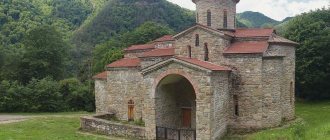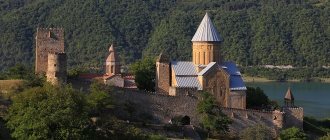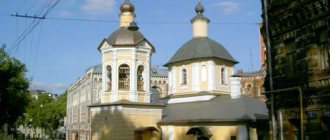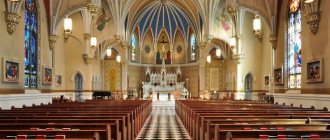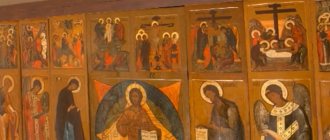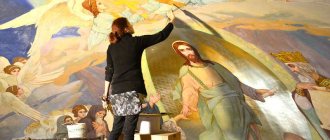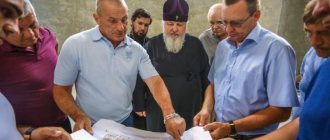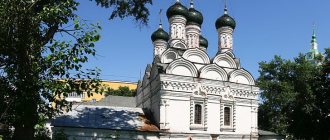The architecture of churches is one of the most painful issues in modern urban development. On the one hand, we see multiplying temples of the same type. On the other hand, we are increasingly faced with controversial projects that flirt with modernity. We asked the co-founder of the Quadratura Circuli bureau, Daniil Makarov, and the curator of MARCH Lab projects, Philip Yakubchuk, to talk about the problems, trends and future of church architecture in Russia.
Makarov: We have a situation in which each direction of architecture within the framework of postmodernism has chosen its own stylistic preferences: airports gravitate towards the so-called high-tech, business centers are usually covered with glass in the manner of modernist skyscrapers, housing is clothed in an infinite number of different shells with Due to the monotony of the internal structure, office buildings in a historical context often decide to play a purely postmodern game with architectural elements, and temple architecture has chosen historicism as its main distinguishing feature.
This division is quite arbitrary; theoretically, nothing prevents the temple from taking on the forms of the 15th century, but from combining the constructive developments of modernism and the postmodern interpretation of modernism. This is how, for example, the St. George Church on Poklonnaya Hill turned out.
Church of St. George the Victorious on Poklonnaya Hill. Source: wikipedia.org
At one time it was considered cutting-edge, but now we can say that it has never become more modern than other temples of the mid-nineties. He simply quoted, compiled and transformed images other than those of his contemporaries, in which ancient Russian temples can be discerned.
And if secular architecture has gradually outgrown the concept of a “city of a captive globe,” then church architecture, by inertia, continues to oppose itself to its surroundings, locking itself in its own narrative, reproducing familiar images, which every year cope less and less with the function of aesthetic and functional satisfaction, but still They are now solving the problem of recognition.
In other words, there is no prohibition on new forms and non-standard solutions for church architecture, which is confirmed by non-standard Orthodox churches of different years of construction, which do not refer in their appearance to pre-revolutionary prototypes. But for historical, cultural and other reasons, church architecture chose and occupied the optimal niche in a bygone era.
what church can be considered modern
Makarov: All the churches that were built in recent decades are modern not because they were built in our time, but for a completely different reason. For 70 years, the construction of temples was prohibited, and repressive actions against religion left the pain of loss in the memory of believers for a long time. And it was quite natural after the ban was lifted to begin to restore lost or damaged architecture.
But the key point is that the desire to build new temples in the forms of historical architecture coincided with postmodernism, which was quite developed conceptually at that time, and it was perfectly suited for this kind of reconstruction, moreover, it implied this. Therefore, on the one hand, the church architecture of recent decades turns out to be both modern due to the fact that it manifests the ideas of postmodernism, which we have found, and on the other hand, it is outdated, because we have not yet seen a single example that has outgrown the ideas of citation, copying and flirting with history.
I think that modern can now be fully considered those churches that offer, in addition to a fresh architectural image, not necessarily a fundamentally new one, also the elaboration of flexible social scenarios of parish life, interaction with the city, openness, and economic sustainability. Aesthetically, modernity will manifest itself in minimizing decoration, reducing formal copying and aestheticizing the remaining architectural details.
Krutitsky Patriarchal Metochion
Address: 1st Krutitsky Lane
This is an unusual temple in Moscow, called a unique island of antiquity. The first building in the princely village of Krutitsy on the Moscow River was erected in 1272. Over time, the institution was transformed into an Orthodox monastery for men, and then into an episcopal residence. In the early 1990s, Krutitsy was given honorary status and is now called the courtyard of the Patriarch of Moscow and All Rus', and since 2001 the Synodal Department of the Russian Orthodox Church has been functioning here, deciding the affairs of young people.
Be sure to take the opportunity to go on a tour of the Krutitsky courtyard. Wooden buildings, cobblestone streets, and wide crowns of fruit trees create a completely unique atmosphere. Here the soul freezes and waits for a miracle.
The architectural ensemble of the Krutitsky courtyard includes beautiful churches, also recognized as shrines of Moscow:
- small Assumption Cathedral;
- Holy Gate;
- Church of Peter and Paul;
- Embankment;
- Order chambers;
- Bell tower.
The Krutitsy family failed to avoid restoration work, but here artists and architects tried to preserve as much as possible the original appearance of the popular attraction. Once here, tourists feel that time has stood still in the 13th century, the exterior seems so ancient.
Are you going on an excursion? Then take the metro and go to Proletarskaya station. From here you should move towards the sign 3rd Krutitsky Lane, and then go to Simonovsky Val. 1st Krutitsky Lane is literally 50 meters from this street.
Why the clergy does not accept new forms
Makarov: There are historical, sociological, anthropological, theological, philosophical and a number of other reasons. To summarize, modern church building was largely influenced by the history of the 20th century. The desire to restore what was lost after the change in policy in the 90s overlapped with a period in architecture in which deconstruction and citation were part of the main tools of architects.
The found approach to church architecture turned out to be so successful and appropriate over time that it is not easy to overcome it. It is not enough to say “we need modern churches, because we live in the 21st century,” for this it is also important to have a theological, philosophical justification for the surrounding cultural processes, which will provide additional support in the creation of forms.
Perhaps the topic of theoesthetics, which has developed in recent years in the church academic environment, will take the understanding of church art to the next level, but for now we have the argument of escapism and the fight against modernism.
Yakubchuk: A significant part of the Orthodox community perceives very sensitively, in fact, an absolutely everyday issue of the church life of a separate parish. On the one hand, this is a consequence of the centralization of church power: the everyday issue of a separate parish for some reason becomes the central topic for discussion of the entire community. On the other hand, this is a side feature of our neophyte.
We tend to perceive the entire church structure in an isosacral way. That is, for us, at first, the commandments of Christ, the shape of the candlesticks in the temple and the random words of grandma on the candle box are equally sacred. We take everything so close to our hearts that we consider it all unshakable. It turns out to be a paradox. The inability to generate new forms in church architecture and church arts is a consequence of our “church youth”: the number of active believers has grown rapidly over the past 30 years, all this is still new for us, and we are not yet able to independently create new forms of church life without looking back at the past. life and church culture. We'll get there.
St Basil's Church
Address: Red Square, 2
It is called the wonder of the world; it occupies a leading position in the list of the main capital attractions. The Intercession Cathedral, representing a collection of 8 church altars, grouped at the throne of the Intercession of the Mother of God, was erected in the 16th century at the behest of Ivan IV, marking the capture of Kazan. Until the 17th century it was called Trinity, and after the completion of the tenth church, consecrated in the name of St. Basil the Blessed, it was renamed.
Historians have not solved the mystery of the color palette of the domes of Heavenly Jerusalem. It is believed that the choice of color was associated with the dreams of the righteous Andrew the Fool, who dreamed that the peaks should be decorated with “golden foliage, flowers and fruits.”
For the 350th anniversary of the founding, the temple walls were painted. Here, 2 sides show excerpts from the life of the saint, made with oil paint, there are ancient ornaments and a huge icon created in the 20th century. Another side is occupied by the image of the Intercession of the Mother of God and significant saints.
In the 19th century, an iconostasis was installed in the cathedral, made according to the design of the famous architect Pavlinov. It consists of icons created by talented craftsmen in the 18th century, as well as later works of Russian icon painters.
St. Basil's Cathedral is located near the metro stations Ploshchad Revolutsii and Kitai-Gorod. The easiest way to get here is by taking the subway.
MAIN trends in church construction
Makarov: There are several trends, some of which are associated with the next revision of history and the use of those historical architectural forms that have not been interpreted so often over the course of three decades.
For example, the Church of the Intercession in Yasenevo “closed the gestalt” with a Russian-Byzantine theme. It is unclear whether the “imperial” direction will have a long continuation after the Cathedral of the Sretensky Monastery, the Church of the Armed Forces and the Church of St. Prince Vladimir in Tushino.
Church of the Intercession of the Blessed Virgin Mary in Yasenevo. Source: Andrey Kolychev / panoramio.com
We can especially highlight two emerging directions that can become the main ones: small, low churches, which are easier for the community to maintain, and church-complexes, which in one simple or developed volume contain premises for both worship and parish activities. The first includes the Church of Seraphim of Sarov in Kozhukhov, the second - the Church of St. Ignatius the God-Bearer in Novogireevo and the Church of St. Sergius of Radonezh on the Khodynka field.
Yakubchuk: For myself, I distinguish the following trends in modern church construction: grandeur, fabulousness, utilitarianism. Greatness is intended to amaze in scale, to demonstrate strength, power, and rootedness in space and time. Typical representatives are the Cathedral of Christ the Savior and the new cathedral in the Sretensky Monastery. It seems to me that these are mainly projects related in one way or another to the state.
Church of the Resurrection of Christ and New Martyrs in Sretensky Monastery
“Fairy-tale” temples are characterized by historical forms, realized through the graphic culture of the Art Nouveau or modern fantasy era, depending on the outlook of the authors and customers of the project. The best temples of this direction seem to have come out of Bilibin’s illustrations. These are the projects of the master of today's temple construction, Andrei Anisimov. In a sad case, we get a temple in Peredelkino. It would seem unfair to put these temples on the same line: some are academic and subtle, others are distilled kitsch. However, they have a common desire to appear in a fairy tale and pretend that the bloody 20th century for the church never happened at all. These are usually sponsored or ordinary temples of the 200 Temples program.
Princess on the tower tower. Illustration for the fairy tale “The White Duck”. Ivan Bilibin. Source: artchive.ru
Illustration for the epic “City of Kitezh”. Ivan Bilibin. Source: artchive.ru
The third direction is utilitarian. In it, I would combine all attempts to resolve the issue of building a church using minimal means with the help of a living parish community. These are all kinds of trailers, wooden temporary temples, adaptation of household premises for temples, construction of economical temples in the simplest forms.
People here often solve pressing problems of church life without the participation of an architect and often find quite elegant and simple solutions. This direction seems to be the most stable and promising. Its practices are the least ideological and the most practical. It's not always pretty, but it always works.
Blagoveshchensky cathedral
Address: st. Dvortsovaya, 1v
This is without a doubt the most revered temple in Moscow. The ancient Orthodox building, erected in the second half of the 14th century, was considered the home church of representatives of the royal family: members of the ruling dynasty were baptized, married and buried here. The first wooden church was built by the son of Dmitry Donskoy right next to the entrance to the house where the Tsar’s family lived, and only a century later, by order of Ivan III, a cathedral of stone was erected on this site. The walls were painted by the most famous Russian craftsmen: Andrei Rublev and Feofan the Greek. Thanks to their skill, the interior of the cathedral amazes with the splendor of the faces of the saints.
The Annunciation Cathedral, with white walls and golden domes, is located in the southwest of Cathedral Square and is part of an admirable architectural ensemble. According to an ancient custom, on the day of the Annunciation, birds were released from the porch into the wild - and today this tradition has not been abolished.
role models in modern church architecture
Church of St. Seraphim of Sarov in Kozhukhov. Source: moseparh.ru
Project of the Church of the Hieromartyr Ignatius the God-Bearer in Novogireevo. Source: hram-gireevo.ru
Makarov: I’m not sure that there are specific examples that could completely set the level to which it is worth emulating. Rather, there are individual successful solutions in different projects. I see the already mentioned Church of Seraphim of Sarov in Kozhukhov, the Church of St. Ignatius the God-Bearer in Novogireevo, Church of St. Sergius of Radonezh on the Khodynka field.
Temple of St. Sergius of Radonezh on the Khodynskoe field. Source: Andreykor / wikimedia.commons.org
Temple of the Kazan Icon of the Mother of God in Havana. Source: Ντμίτρι / wikimedia.commons.org
Yakubchuk: Roughly speaking, such a temple has not yet been built. Of those built, the closest to my personal expectation from church architecture today is the Kazan Church in Havana. The project cannot be called innovative, but it’s just good. Very tactful construction, amazingly faithful to traditional forms and at the same time absolutely fresh and modern.
Novodevichy Convent
Address: Novodevichy Proezd, 1
The Novodevichy Convent is an impressive ensemble of architectural monuments that appeared at the turn of the 16th-17th centuries. This object, the founder of which is called the Prince of All Rus' Vasily III, is included in the UNESCO World Heritage List and has retained its original appearance to this day. The Novodevichy Convent amazes with the beauty of its architecture. Today, Orthodox services are held here, and the halls of the Historical Museum also invite guests.
The monastery complex includes 14 buildings. Of these, 8 are temples, and 6 are buildings for household needs. On the grounds of the monastery stands the six-pillar Smolensk Cathedral. Its walls are decorated with unique frescoes of the 16th century, and there is also an icon with the miraculous face of Hodegetria - the work of the Evangelist Luke. In the Church of the Transfiguration there is a carved iconostasis, surprising with the subtlety of writing and painting of icons. A beautiful 6-tier bell tower, surrounded by white stone balustrades, was also built here.
The monastery is also known for its cemetery - Novodevichy. Its old part is located on the territory, and the new one is behind the wall. This is a real attraction for foreign tourists, because here are the graves of Yeltsin, Nadezhda Allulieva, Agnia Barto, Anton Chekhov, Lyudmila Gurchenko and many other political and cultural figures, composers, scientists.
You can get to the Novodevichy Convent from Sportivnaya station.
Is Russia ready for such experiments?
Makarov: So far, it’s more likely no than yes, but in the “200 temples” program there is feedback on the results of construction: the standard first-wave temples, made using the prefabrication method, turned out to be very inflexible and not as cheap as expected. The churches of the second wave were not typical and more consistent with the needs of the parish, but at the same time they used the old approach to development, which did not always make efficient use of the territory. Now we see experiments with the layout of churches and parish buildings, I think that soon the aesthetic problem will also be in the spotlight.
Yakubchuk: I think we are still at the stage of accumulating requests for new forms. This demand grows naturally through a change of generations and sooner or later will lead to the emergence of truly new forms. Paper projects are very important in this process. While these churches are gathering their virtual flock in the form of comments: “Wow! I would go/went to such a temple!”
Why did the transition to modern forms happen much earlier in the West?
Makarov: In the West there has always been a progressive development of church architecture in parallel with the development of all other art and culture, without any dramatic transitions. There were no historical factors that would remove church art from the sight of cultural figures.
Yakubchuk: I don’t think there was any special transition there. There is a progressive evolutionary process underway, not greatly disturbed by global upheavals, as was the case with us. Still, the persecution of the church in Soviet times was a powerful tectonic shock, according to some estimates, surpassing even the Roman persecutions of early Christian times. We as a society have not yet recovered from those traumas; architecture is only a consequence of this trauma. While we intensely yearn for the lost past.
